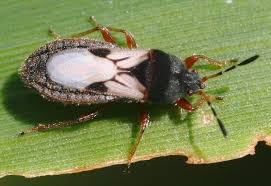Chinch Bug Concerns

There are a lot of diseases, weeds, and bugs that are out to kill your grass, but if we had to name ‘Central Florida’s Most Wanted Sod Slaughterer,’ it would be the chinch bug.
What we have in our yards is the biggest reason why. There are an estimated two million acres of St. Augustine grass covering Florida—and that’s the chinch bug’s favorite snack. The buggers don’t only eat it, they live in it, and raise their disgusting young there too. If you haven’t dealt with chinch bugs consider two things, your lawn is getting top of the line care and the more likely scenario—you’re lucky, very lucky. Experienced landscapers will tell you ‘it’s not if you have chinch bugs, it’s when you’ll have them.’
This blog will help you identify chinch bugs, detail the damage they do, go over a neat experiment to determine if you have an infestation, and most importantly how to get rid of the insatiable insects.
Spotting the suckers
Chinch bugs are small, but not too tiny to spot; adults are black and white. They have wings but don’t fly very much. The young are usually orange or yellow and live deep in the thatch, while the adults are on the top of the turf. The bugs sink their mouths onto the grass blades and suck them dry. The mama chinch bugs lay about 250 eggs each, so it doesn’t take them long to make huge and hungry families.
The pests can be deceiving. What they’re doing to your lawn resembles other issues like brown patch disease and irrigation problems, so it’s crucial to catch them before they take over your whole yard.
Here’s some even more bad news, they are active in hot and wet seasons, and you don’t need us to tell you that the heat is most definitely on across Florida and you can almost set your clock by that window-rattling rain that hits every afternoon.
The easy way to check for chinch bugs is to inspect the dead spots in your lawn. The best place to check is at the border between the ugly brown and still green grass. The bugs should be seen going from the area that they’ve already eaten to their new feeding grounds.
If you’re still unsure, here’s a test that will only take you about five-minutes. Cut the bottom out of a metal coffee can, so it’s open on both sides and place it upside down on the edge of the brown patch in your yard. Then, push the can into the turf, use a knife or small shovel to push the can at least three inches into the soil. Fill the can with water for a few minutes. If you have chinch bugs, you’ll see them floating on the top of the water.
Beating the bugs
The best way to keep the buggers at bay is to maintain a healthy lawn, which means proper irrigation and keeping the blades between three and four inches long. Remember, when you cut the grass don’t remove more than a third of the height of the blades.
If you have them, don’t despair, but act fast. Chinch bugs are quick eaters, and it won’t be long until they turn your whole yard brown. We have the solutions to evict them from your yard (well, not really evict, we kill them, but we don’t want to sound too cruel) while keeping you and the people and pets who play in your yard safe.
Put your mind and turf at ease— contact us to take care of any chinch bug concerns.
